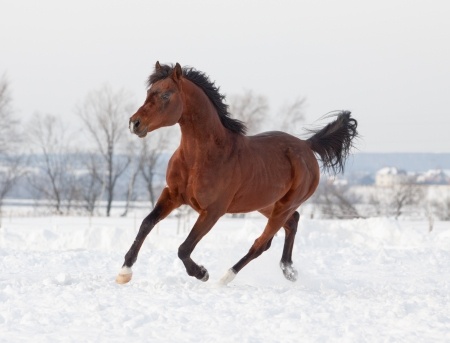
Now that winter has finally set in, you’ve probably found yourself extra busy taking care of the additional chores around the barn. From unpacking your horse’s winter blankets, dealing with frozen water troughs and buckets, and clearing snow and ice from walkways, you might not be riding as much as you’d like. But your horse’s hooves still grow during the winter months, and your horse will need regular hoof care in the winter as he does during the rest of the year.
Regular Farrier Care
Meet with your farrier to discuss what plans you should make for your horse’s hoof care in the winter. Horse’s hooves tend to grow more slowly in the winter – it could be because your horse is not getting as much exercise as he gets during the spring and summer months, and it can also be because colder temperatures tend to slow down the circulation in the hoof (plus more energy is used by your horse to keep warm). But even with slower hoof growth, your horse will still need regular farrier visits. Without regular farrier care, your horse’s hooves can develop flares or cracks, or other problems such as thrush or white line disease. So even though it’s wintertime, make sure you keep up your regular hoof care schedule.
Hoof care in the winter can be a bit tricky since you are also now dealing with frozen, uneven ground that can damage your horse’s hooves, along with a number of other other challenges that ice and snow can present. If possible, take a look at last year’s calendar and try to remember what dates you had the first frost, a first snow and even a first “real” snow, meaning snow that was on the ground and stayed for a few days. You can use this information to help work with your farrier in planning any winter shoeing changes you might want to make.
Shoeing Options
Depending on your horse’s use, activity level and hoof quality, you may or may not want to keep shoes on him during the winter. Some people prefer to keep their horse barefoot in the winter, while other people will leave just the front shoes on their horse. And many people will keep all four feet shod during the winter months, some changing over to winter shoes and snow pads. Every horse is different, and what is best for one horse may not work for another horse, so the best plan of action is to speak with your farrier about your horse’s hoof care in the winter months, based on his own individual needs.
Choice #1: No Shoes
Many people keep their horse barefoot during the winter months if they do not shoe their horse during the rest or the year, and others may pull their horse’s shoes off during the winter if they are not being ridden during this time. If the hoof is healthy and strong, there should not be an issue with cracking or bruising; in fact, it’s quite likely the hoof will develop strong frogs and bars when barefoot. Also, a bare hoof is less prone to slipping on ice and usually does not ball up with snow. However, if your horse is accustomed to wearing shoes during the year and you decide to leave him unshod during the winter, he could develop sole bruises especially if his soles are thin or flat, or if he has conformational issues that you had previously been addressing with shoes. If you decide to keep your horse barefoot during the winter, make sure to check his feet daily and have them trimmed regularly by your farrier.
Choice #2: Shoes on Front Feet Only
A popular option for many horse owners is to shoe the front feet only, and keep the back feet barefoot during the winter months. The front feet are shod according to what you and your farrier have decided is best for your horse, while the back feet can have some of the benefits of being barefoot. This is a good option especially if your horse needs front shoes for support or is shod for therapeutic reasons. If you choose this option for your horse, check your horse’s feet daily to make sure he hasn’t caught and pulled his front shoes on anything that could be buried under the snow. Also, check his back feet regularly for signs of hoof splitting or sole bruising.
Choice #3: Shoes on All Four Feet
If you ride your horse regularly during the winter or live in areas where the weather is mild and you don’t have a lot of ice or snow, you might want to keep your horse shod during the winter months just as you do during the rest of the year. This is especially true if your horse has conformational issues or needs shoes for the support and structure that shoes can provide.
Snowballs
As you and your farrier evaluate your horse’s hoof care in the winter, if you decide to keep your horse shod (either front feet only or fully shod) and you live in an area that has ice and snow, make sure you check your horse regularly for ice or snowballs that can build up in his hooves. Snowballs can be a problem for horses that wear shoes during the winter, since the wet snow gets packed into the hoof and melts slightly when it comes in contact with the sole. When the snow then touches the cold metal horseshoe, it refreezes and eventually forms snowballs in the bottom of the hoof. This not only makes it difficult for your horse to walk, but it can lead to tripping or slipping, or may even put increased pressure on your horse’s joints and tendons leading to soreness or injury. Some people have tried home remedies such as cooking spray or petroleum jelly, and others may use commercial products such as Musher’s Secret but these solutions may work for only a short period of time, and they will quickly wear off.
Winter Snow Pads
If you decide to keep shoes on your horse during the winter and you live in a location with snow and ice, you should discuss with your farrier the option of adding pads under your horse’s shoes when the ground freezes. Snow pads can help prevent sole bruises from hard, uneven ground and this extra protection could be a good choice for your horse. Winter pads come in two different styles – snowball bubble pads (also known as “popper” pads) and snow rim pads.
Bubble pads are pads that cover your horse’s entire foot and are called so because they have a large bubble in the middle that helps keep snow out of the hoof. The bubble expands and contracts, so every time your horse puts weight on it, it pushes out the snow so it can’t build up in the hoof. The downside is that since it covers the entire hoof, dirt and debris can build up inside the pad, possibly causing sole pressure, discomfort or thrush.
Snow rim pads are the other type of pads commonly used to help keep snow out of the horse’s hoof. The design is a hollow U-shaped tube that is placed between the shoe and the hoof, and like bubble pads, they expand and contract as weight is put on the hoof. The difference is, however, that the sole is not covered as it is with bubble pads. It is possible that dirt and debris can work its way into the tubing, so you’ll need to check regularly to make sure the tubes are clear and are functioning properly.
Winter Care
A big part of your horse’s hoof care in the winter will include checking his legs, pasterns and hooves regularly for issues that can arise from exposure to the rain, mud, snow and ice. You’ll probably agree that it’s a lot easier to be regularly proactive than it is to suddenly have to be reactive at a later time when problems arise. Horses are more susceptible to hoof bacterial infections like thrush, especially in conditions where there are wet conditions such as mud or wet bedding. Thrush can be easily treated with over the counter medications, but if left untreated, thrush can travel deep into the sensitive tissue within the frog causing pain and lameness. Horses that are exposed to excessively muddy or wet conditions are also more prone to developing scratches (also known as pastern dermatitis) which is typically caused by viral, bacterial or fungal infections. In addition to these challenges, winter weather can also dry out your horse’s hooves, leading to chipped or cracked hooves. A great way to help combat the effects of the winter elements on your horse’s hooves is to give him Hoof ReNu, a high quality hoof supplement with 50 mg. of biotin plus amino acids, trace minerals and vitamins needed to support hoof health.
So by working with your farrier and coming up with a game plan on how to take care of your horse’s hooves during the winter, plus spending some extra time taking care of problems before they become bigger issues, you’ll be able to help your horse get through the winter safely.






Leave a Reply